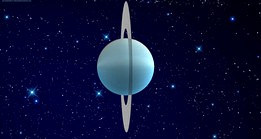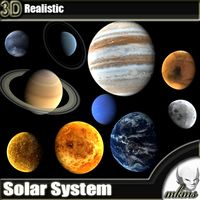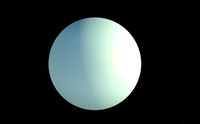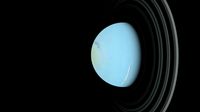GrabCAD

URANUS
by GrabCAD
Last crawled date: 1 year, 10 months ago
Uranus is the seventh planet from the Sun. It has the third-largest planetary radius and fourth-largest planetary mass in the Solar System. It is named after the ancient Greek deity of the sky Uranus (Ancient Greek: Οὐρανός), the father of Cronus (Saturn) and grandfather of Zeus (Jupiter). Though it is visible to the naked eye like the five classical planets, it was never recognized as a planet by ancient observers because of its dimness and slow orbit. Sir William Herschel announced its discovery on March 13, 1781, expanding the known boundaries of the Solar System for the first time in modern history. Uranus was also the first planet discovered with a telescope.
Uranus is similar in composition to Neptune, and both are of different chemical composition than the larger gas giants, Jupiter and Saturn. Astronomers sometimes place them in a separate category called "ice giants". Uranus’s atmosphere, while similar to Jupiter and Saturn’s in its primary composition of hydrogen and helium, contains more "ices" such as water, ammonia and methane, along with traces of hydrocarbons. It is the coldest planetary atmosphere in the Solar System, with a minimum temperature of 49 K (−224 °C). It has a complex, layered cloud structure, with water thought to make up the lowest clouds, and methane thought to make up the uppermost layer of clouds. In contrast, the interior of Uranus is mainly composed of ices and rock.
Uranus is similar in composition to Neptune, and both are of different chemical composition than the larger gas giants, Jupiter and Saturn. Astronomers sometimes place them in a separate category called "ice giants". Uranus’s atmosphere, while similar to Jupiter and Saturn’s in its primary composition of hydrogen and helium, contains more "ices" such as water, ammonia and methane, along with traces of hydrocarbons. It is the coldest planetary atmosphere in the Solar System, with a minimum temperature of 49 K (−224 °C). It has a complex, layered cloud structure, with water thought to make up the lowest clouds, and methane thought to make up the uppermost layer of clouds. In contrast, the interior of Uranus is mainly composed of ices and rock.
Similar models
3dwarehouse
free

otter solar sysatem
...
the outter solar system and its planets:jupiter,saturn,uranus,neptune #jupiter #neptune #planets #satyurn #solar #system #uranus
3d_export
$270

Solar System 3D Model
...ranus neptune pluto space globe clouds orbit terra nasa planet planets atmosphere solar
solar system 3d model mkms 37588 3dexport
3dwarehouse
free

Planets of the Solar System
...planets #sun #mercury #venus #earth #mars #jupiter #saturn #uranus #neptune #pluto #moon #rings #universe #atmosphere #globe #map
cg_trader
$2

Solar System
... space solarsystem planets earth sun milkyway saturn jupiter uranus planet earth planet jupiter planet planet earth space planets
grabcad
free

JUPITER
...t object in the night sky after the moon and venus. (mars can briefly match jupiter’s brightness at certain points in its orbit.)
grabcad
free

SATURN
...cond largest moon, is larger than the planet mercury and is the only moon in the solar system to retain a substantial atmosphere.
3dwarehouse
free

solar system
...saturn, uranus, neptune, pluto. #earth #jupiter #mars #mercury #neptune #planets #pluto #saturn #solar_system #sun #uranus #venus
3dwarehouse
free

The Solar System
..... #asteroid_belt #earth #jupiter #mars #mercury #neptune #planet #planets #pluto #saturn #solar #sun #system #the #uranus #venus
cg_trader
$8

Solar System Planet Pack
...enus earth mars jupiter saturn uranus neptune astronomy space earth planet jupiter planet saturn planet venus planet planet venus
3dwarehouse
free

The Solar System
...
3dwarehouse
a 1:1000000 scale model of our solar system #earth #jupiter #mars #mercury #neptune #planets #saturn #uranus #venus
Uranus
turbosquid
$60

Uranus
...uid
royalty free 3d model uranus for download as 3ds and max on turbosquid: 3d models for games, architecture, videos. (1299337)
turbosquid
$59

Uranus
...oyalty free 3d model uranus for download as max, obj, and fbx on turbosquid: 3d models for games, architecture, videos. (1259246)
turbosquid
$60

uranus
... available on turbo squid, the world's leading provider of digital 3d models for visualization, films, television, and games.
turbosquid
$50

Uranus
... available on turbo squid, the world's leading provider of digital 3d models for visualization, films, television, and games.
turbosquid
$45

Uranus
... available on turbo squid, the world's leading provider of digital 3d models for visualization, films, television, and games.
turbosquid
$10

Uranus
...by deans products for download as c4d, 3ds, fbx, obj, and stl on turbosquid: 3d models for games, architecture, videos. (1612694)
3d_ocean
$6

Planet Uranus
...et galaxy hole meteor nebula planet science space spaceage star sun texture travel universe uranus world
realistic planet uranus.
3d_export
$5

uranus planet
...uranus planet
3dexport
turbosquid
$7

Realistic 1k Uranus Planet v1 / Planete Uranus
...odel planete uranus v1 / uranus planet v1 for download as lwo on turbosquid: 3d models for games, architecture, videos. (1538580)
turbosquid
$100

Uranus And Satellite
...alty free 3d model uranus and satellite for download as blend on turbosquid: 3d models for games, architecture, videos. (1332835)
